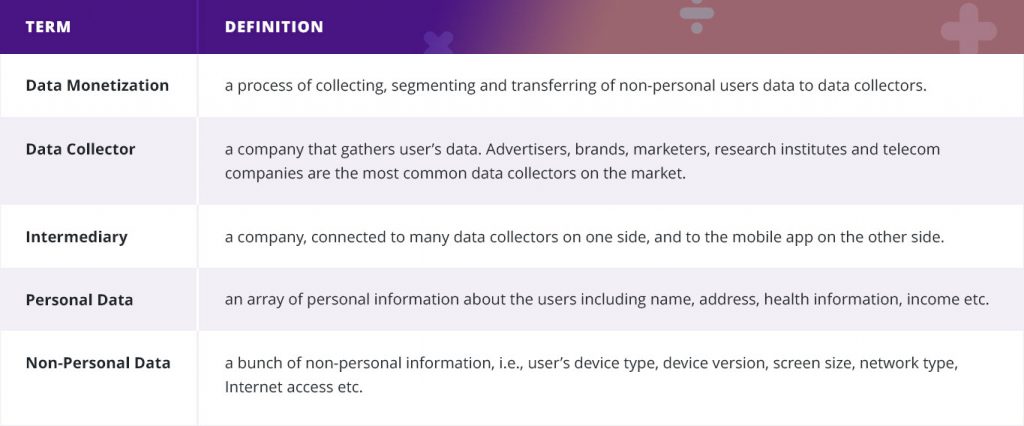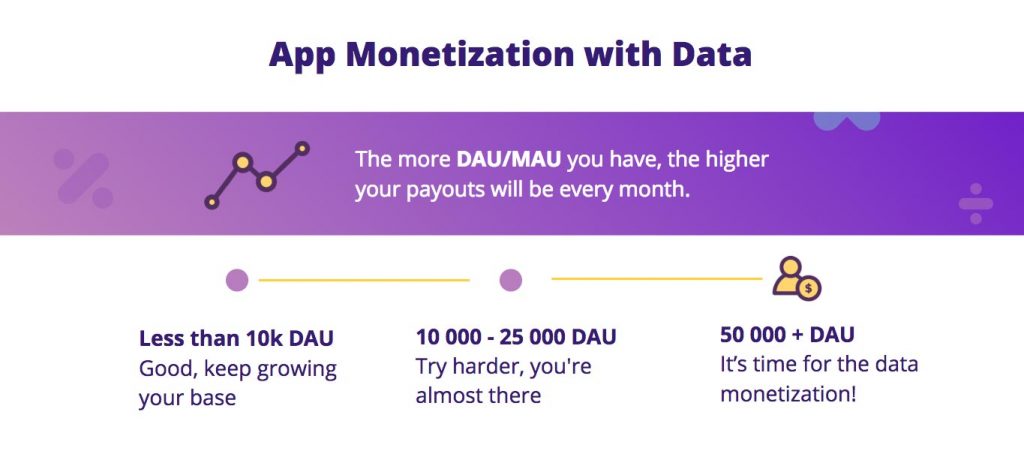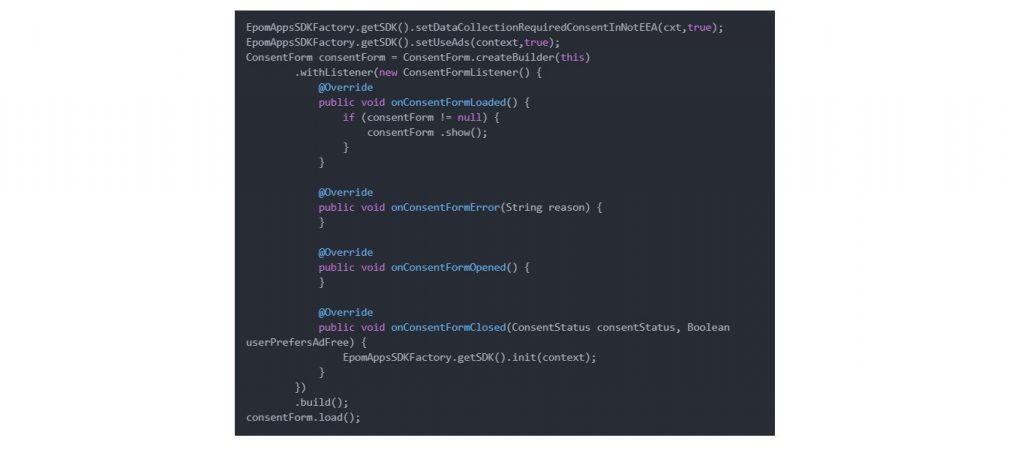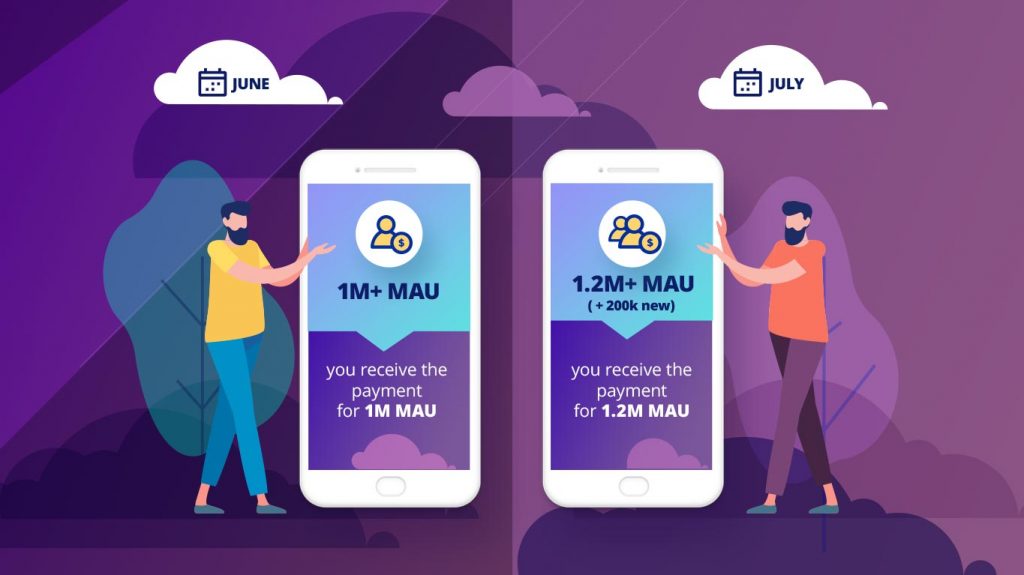In a modern data-driven world, data about users means a lot. Today companies seek out quality data from users to make major business decisions, to analyze the audience that they are targeting or just to enhance their products.
The International Institute for Analytics forecasts that Internet users will generate over 180 trillion gigabytes of data by 2025. This tremendous amount of data will turn into one of the main revenue sources for publishers. As users spend over 80% of their mobile minutes on apps, app developers are the ones who can benefit the most from this massive data interest.
In-app data monetization has proven to be a sustainable alternative to in-app advertising. In this article, we’ll dive deep into data monetization and explain how to make your users’ data drive solid revenue to your mobile app. For a better understanding of what the process of data monetization is, let’s walk through a short glossary:

Why do app developers get into app monetization with data?
Compared to other app monetization strategies, in-app data monetization boasts its explicit benefits for app developers:
- In-app data monetization is a scalable revenue-driver. Once added to your app, data monetization SDK will drive sustainable earnings for the months/years to come.
- With data monetization, you can capitalize on 100% of app users.
- Data monetization generates revenue to any category of mobile apps.
- After one-time SDK integration, you won’t have to invest time or efforts into the process onward. Everything works properly from the very beginning.
- The data collection takes place in the background, so the user’s experience stays untouched.
- App monetization with data consumes neither memory nor battery of user’s device.
- From month to month you’ll get paid for every user who agreed with the data collection. The more daily active users (DAU) you have, the higher the payouts will be every month.
- Data monetization won’t harm your existing SDKs. So you can run it separately or along with in-app ads. Two SDKs won’t compete with each other.
Preparing your app for successful data monetization
As data monetization works only with non-personal data, data collectors are usually interested in buying it in bulk. The more non-personal data that is put together, the more precise it becomes. That’s why apps with a significant number of DAU have higher chances to monetize their data at competitive rates. To make your app appealing for data collectors, invest some time in growing your user base first.
For example, if you have less than 10 000 DAU you should keep growing your user base. Overstepping the mark of 25 000 DAU means you should try a little bit harder as you’re almost ready for data monetization. When your app reaches 50 000+ DAU it’s now time to try out app monetization with data.

Then, look around to find the data collector for your app. You can both set up direct partnerships with data collectors or monetize your data with companies-intermediaries. What’s the difference? Here the situation reminds the ad mediation. The more data collectors you have in the pool, the higher percentage of app users you’ll monetize. As a result, the more revenue your app will receive.
If you are too busy to contact data collectors one by one, think of monetizing your data with intermediaries like Epom Apps. Epom Apps signed up contracts with telecom companies, marketers, various online services and research institutes. As a result, they are able to pay for 100% of the user’s data that they gather. They receive data from their partner apps and transfer it to a dozen of data collectors through a single SDK.
NOTE: Whether you decide to start with various data collectors or a single intermediary, negotiate the parameters you are ready to pass before adding data monetization SDK to your code. Then sign up the IO with all the negotiated parameters and prices included.
1. Add permissions to your code.
Prior to adding data collector’s SDK to your code, you will need to open permissions like these ones:
<uses-permission android:name=”android.permission.INTERNET” />
<uses-permission android:name=”android.permission.ACCESS_NETWORK_STATE” />
Permissions will allow data collectors to gather non-personal information about your users. Hence, data collectors won’t be able to access more data than you enable them to see.
2. Implement SDK from your data collector or add an intermediary to your code.
3. Prepare the user’s consent.
Before tapping into data monetization, you need to ask your users whether they mind sharing their non-personal information. For this, insert a block with User’s Consent to your code. Here’s how the user consent will look like after downloading the SDK on Android:

4. Ask users’ permission to gather non-personal data.
After being added, the consent should be shown to every new user in your app. As soon as the user agrees to share non-personal data, you’ll start earning.

How much can one earn with in-app data monetization?
Whether you start working with data collectors (i.e. Tutela) or intermediaries (i.e. Epom Apps), the company representatives can estimate your future data-driven income.
Let’s assume that your app has 100 000 DAU in the United States. With basic permissions set you’ll be able to make approximately $10 per 1000 users ($1,000/month). Given the fact, that you literally do nothing except add a few permissions and SDK to your code, data monetization seems to be an unprecedented opportunity for your mobile app.
In case you open access to a wider range of parameters like Bluetooth or more precise location, your revenue will grow. The final payment will also depend on the retention and the number of users who stay with your app during the month. The more users you have on your app, the higher average CPM you can expect.
With in-app data monetization, your users don’t lose their value from month to month. Let’s say, you have 1 million MAU in June. In the case that all your users responded ‘YES’ to your user’s consent, you would get paid for 1 million MAU. For instance, the next month you already have 1.2 million MAU (+ 200 000 newbies) and all of them also agreed to share their non-personal data. Your data collecting company will pay for 1.2 million users again even considering the fact that you’ve already received the payment for 1 million users the month before.

If you don’t want to screw up with your in-app data monetization, here are a few crucial things to remember:
- Start monetizing your app with data with at least 50 000 DAU in your pocket.
- Always ask users permission before gathering and transferring their non-personal data.
- Make sure that the user’s consent is noticeable and users can’t miss it when interacting with your app.
- Navigate the market, ask Reddit or your favorite forums for app developers and choose a trusted data collector for your data monetization. Which forums for app developers do you read the most frequently?
- Make sure that the user’s data that you share doesn’t violate the GDPR policy.
- Collect non-personal data only. Let your users stay anonymous and protected.
All in all, in-app data monetization is a hassle-free option to power your app monetization strategy. With minimum time and efforts invested, data monetization can deliver outstanding results to any category of mobile apps. Just remember, that the success of your app completely depends on your users. So make sure you stay transparent and respectful with your audience.

